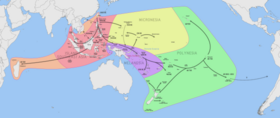Island hopping
This article needs additional citations for verification. (December 2012) |

Island hopping is the crossing of an ocean by a series of shorter journeys between islands, as opposed to a single journey directly to the destination.
Oceanic dispersal in biology, where terrestrial species migrate by sea from one landmass to another, is often achieved by rafting on mats of tangled vegetation—the outcome of which is called a rafting event. This process may be facilitated by geographically intermediate islands that break up the migration into a number of shorter steps. Colonization of a series of islands (or larger land masses) by a sequential rafting process is sometimes described as island hopping. Such a process appears to have played a role, for example, in the colonization of the Caribbean by mammals of South American origin (including caviomorphs and monkeys).[1]
References
- ^ Hedges, S. Blair (2006-08-23). "Paleogeography of the Antilles and Origin of West Indian Terrestrial Vertebrates1". Annals of the Missouri Botanical Garden. 93 (2): 231–244. doi:10.3417/0026-6493(2006)93[231:POTAAO]2.0.CO;2.
- United States National Park Service. "Island Hopping." Accessed February 01, 2016.
